
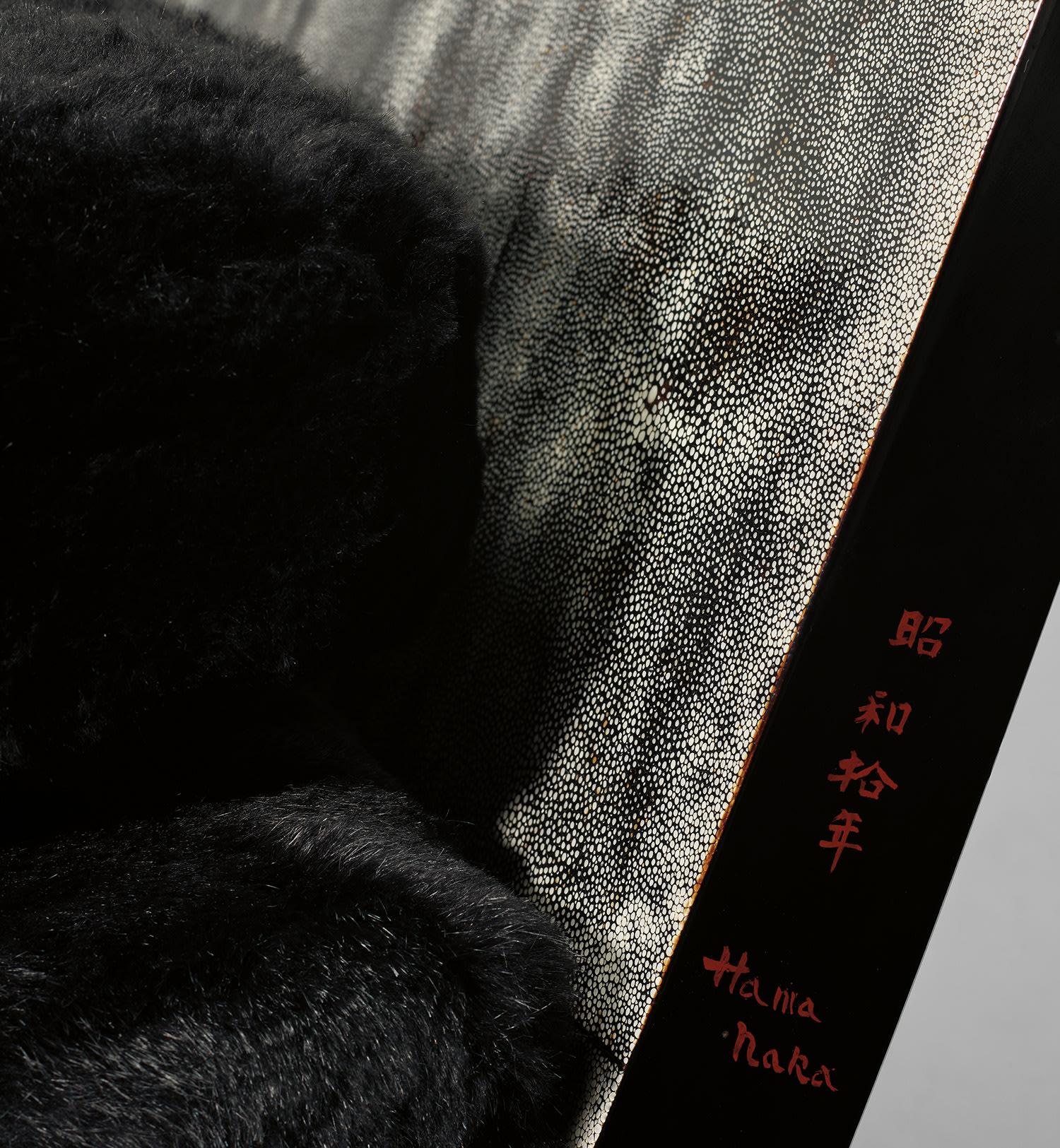
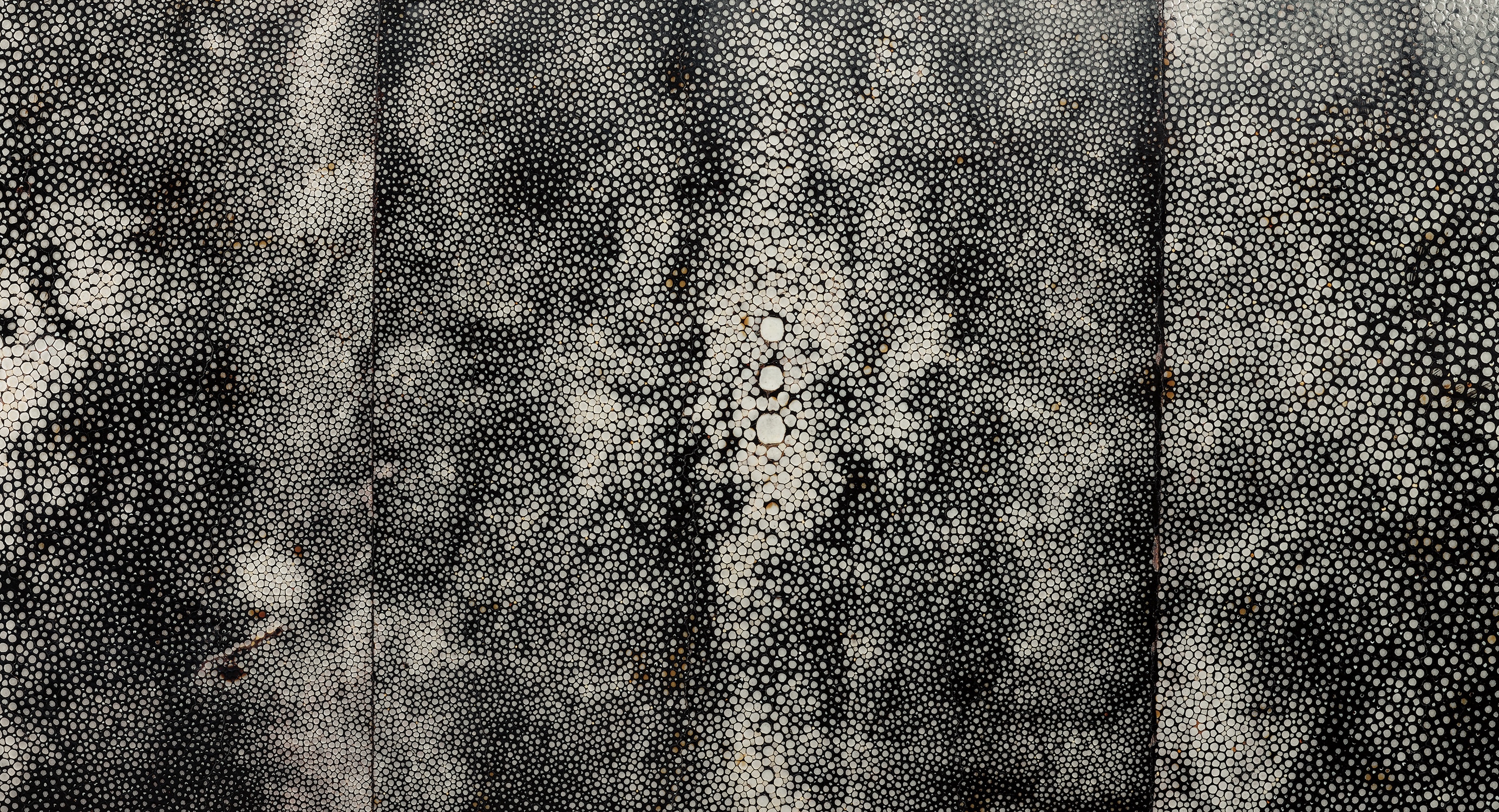
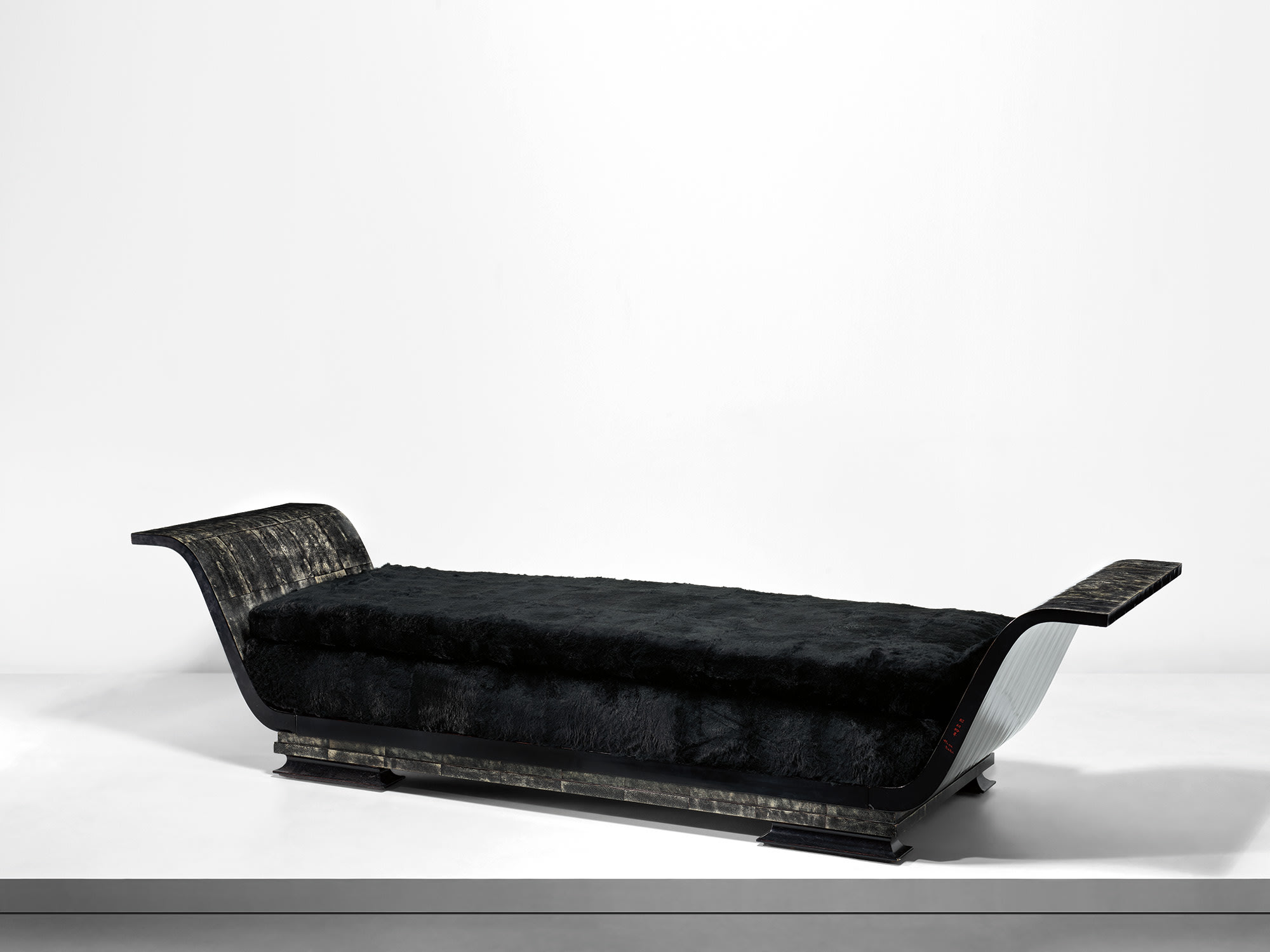

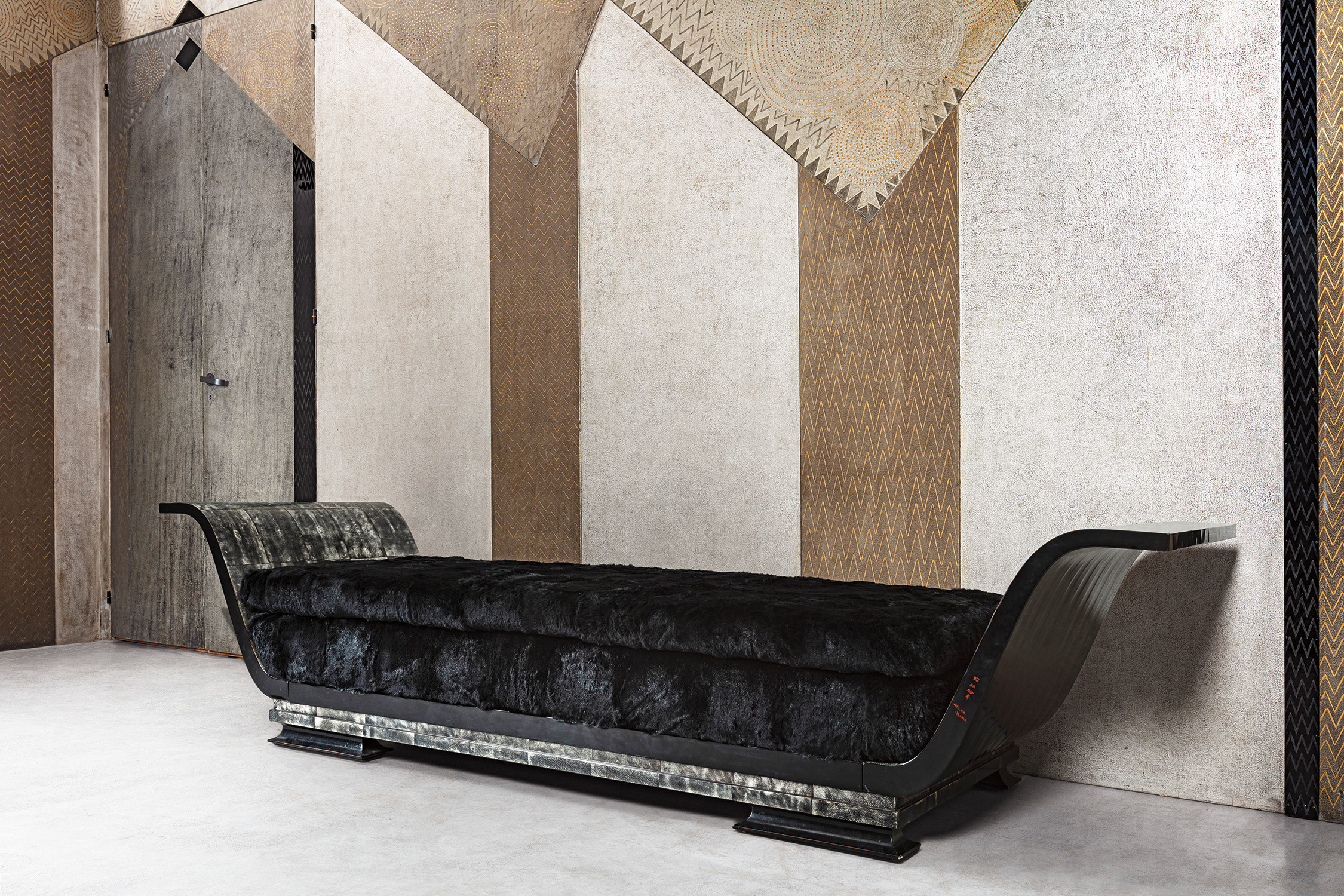
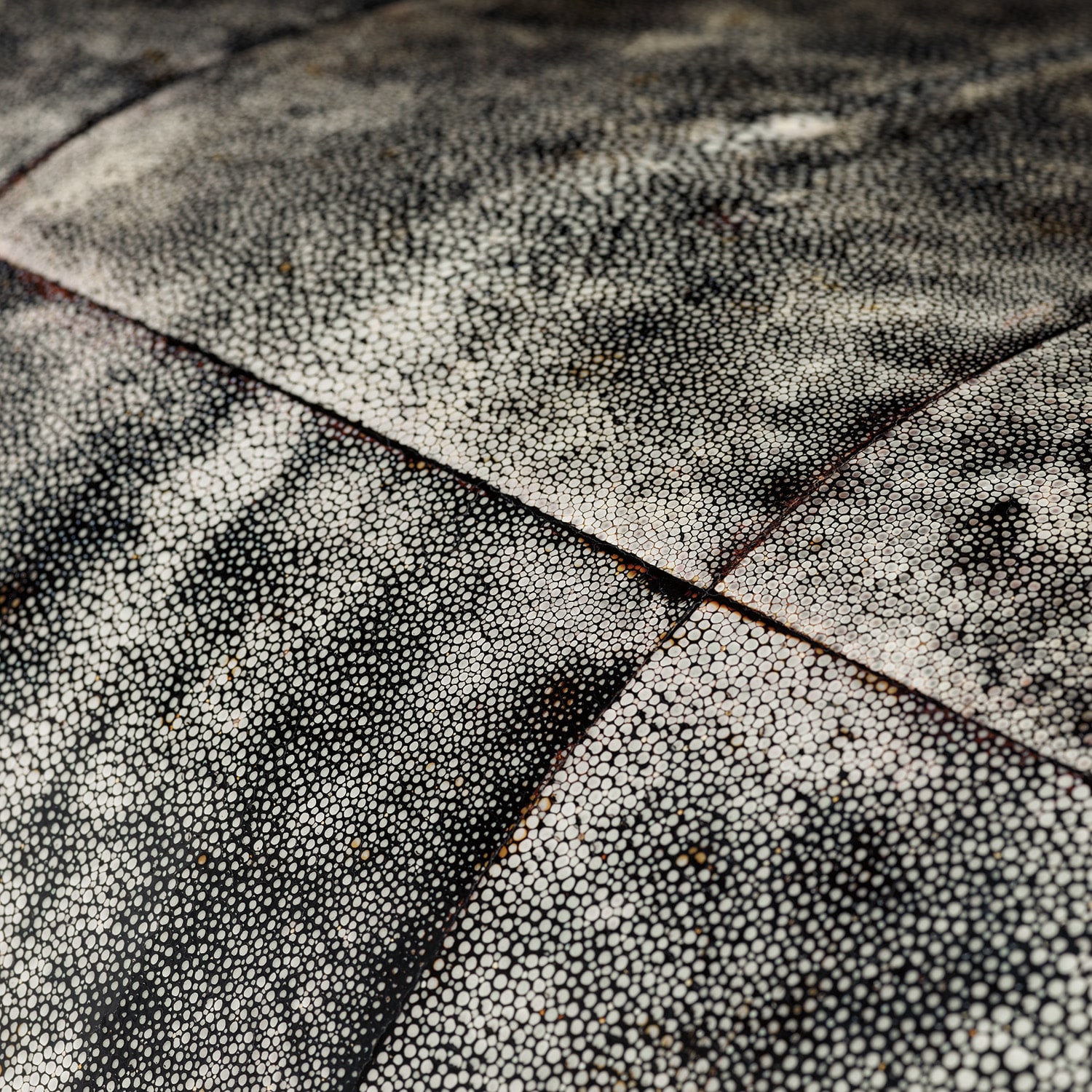







34
Katsu Hamanaka
Daybed, from the residence of Mademoiselle Colette Aboucaya, Paris
circa 1935
Lacquered wood, shagreen, lapin fur upholstery.
70.5 x 303 x 84 cm (27 3/4 x 119 1/4 x 33 1/8 in.)
Stretcher signed Laque/Hama/naka and dated in Kanji 1932. Frame further dated in Kanji 1935 and signed Hama/naka.
Full-Cataloguing
Hamanaka’s Daybed for ‘Les Palmiers’
Born in Sapporo, Japan, Katsu Hamanaka moved to Paris in 1924. An advertisement Hamanaka placed in Le Petit Parisien documents that by 1927 he had opened a workshop at 7, cité Falguière. At that time a community of Japanese artists were residing in cité Falguière, including the painter Tsuguharu Foujita. The 1927 advertisement documented that Hamanaka specialised in the decoration of objets d'art made of ivory, shagreen and precious woods, but made no reference to lacquer. It was only after Hamanaka met the master craftsman Seizô Sugawara, who he was introduced to by Foujita, that Hamanaka began to practice the ancient technique of lacquer.
Distinct from the imitation lacquer varnish prevalent in France during this period, natural lacquer was made from a resin extracted from the Rhus vernicifera—a tree indigenous to China and Japan. Once filtered using fine linen cloth to remove any impurities, the raw material was then stored in sealed bamboo baskets for several months, during which time layers of varying density formed, which were then graded and priced accordingly, and adapted to different stages of use in the lengthy lacquering process. In order to achieve lacquer’s highly lustrous, impermeable surface, numerous thin layers were painstakingly applied to the base surface—which in the case of wood, first must be smoothed before the grain is filled and the surface covered with a thin layer of silk or hemp using rice gum paste. The surface was then prepared by applying initial coats of lacquer mixed with sawdust from exotic woods in order to ensure the evenness of the surface. Between five to fifteen layers of clay-based lacquer were then typically added before the final stages of decorative lacquer layers were applied. Following each coat, the lacquer is slowly dried in a carefully controlled humid and dust-free environment over the course of several days. The surface is then finely sanded before the process is repeated.
Following his instruction under Sugawara, Hamanaka mastered the difficult medium and began regularly exhibiting his lacquerwork at the various salons in Paris, including the 1929 Salon d’Automne and the 1932 Salon des Artistes Décorateurs. Hamanaka’s lacquer workshop was featured in a 1933 issue of L’Intransigeant, in which the journalist described, 'Hamanaka the lacquerer is in his studio, full of fragrant and warm mist… everywhere, little jars for the gum paste and the trialling of different mixtures’. Working with a range of techniques, Hamanaka applied gold and silver leaf, metal fillings, eggshell, shagreen and precious stones to his lacquerwork to further enhance the lustrous surface. In 1937 Hamanaka was awarded the Grand Prix at the Exposition Internationale des Arts et Techniques Appliqués à la Vie Moderne for his monumental panel depicting the 'Three Graces'. It marked the first time an entire section of an exhibition in Paris was devoted to lacquer, for which Jean Dunand was appointed président. Throughout this period, Hamanaka also collaborated with French designers including Dunand, Jacques Adnet, Jules Leleu and Émile-Jacques Ruhlmann to produce decorative panels, screens and furniture.
Hamanaka worked with Dunand on the smoking room for Mademoiselle Colette Aboucaya’s Paris residence completed between 1930 and 1936. For the commission, which was overseen by Mademoiselle Aboucaya’s decorator Gérard Mille, Hamanaka created a set of black lacquer furniture, comprising a pair of side chairs, a pair of armchairs, an occasional table and the present daybed. The four chairs were upholstered in pink silk fabric by Hélène Henry, reflecting the tones of the geometric-motif carpet by Ivan Da Silva Bruhns. The furnishings were set within the abstract palm grove of Dunand’s ‘Les Palmiers’ panels, reflecting an exoticism that inspired the French Art Deco period. The refined simplicity and elegant curved lines of the present daybed evoke the form of a gondola. The use of line is further enhanced by the incorporation of shagreen into the black lacquered frame, creating radiant surface effects and demonstrating the high level of craftsmanship Hamanaka had achieved in his work.
Born in Sapporo, Japan, Katsu Hamanaka moved to Paris in 1924. An advertisement Hamanaka placed in Le Petit Parisien documents that by 1927 he had opened a workshop at 7, cité Falguière. At that time a community of Japanese artists were residing in cité Falguière, including the painter Tsuguharu Foujita. The 1927 advertisement documented that Hamanaka specialised in the decoration of objets d'art made of ivory, shagreen and precious woods, but made no reference to lacquer. It was only after Hamanaka met the master craftsman Seizô Sugawara, who he was introduced to by Foujita, that Hamanaka began to practice the ancient technique of lacquer.
Distinct from the imitation lacquer varnish prevalent in France during this period, natural lacquer was made from a resin extracted from the Rhus vernicifera—a tree indigenous to China and Japan. Once filtered using fine linen cloth to remove any impurities, the raw material was then stored in sealed bamboo baskets for several months, during which time layers of varying density formed, which were then graded and priced accordingly, and adapted to different stages of use in the lengthy lacquering process. In order to achieve lacquer’s highly lustrous, impermeable surface, numerous thin layers were painstakingly applied to the base surface—which in the case of wood, first must be smoothed before the grain is filled and the surface covered with a thin layer of silk or hemp using rice gum paste. The surface was then prepared by applying initial coats of lacquer mixed with sawdust from exotic woods in order to ensure the evenness of the surface. Between five to fifteen layers of clay-based lacquer were then typically added before the final stages of decorative lacquer layers were applied. Following each coat, the lacquer is slowly dried in a carefully controlled humid and dust-free environment over the course of several days. The surface is then finely sanded before the process is repeated.
Following his instruction under Sugawara, Hamanaka mastered the difficult medium and began regularly exhibiting his lacquerwork at the various salons in Paris, including the 1929 Salon d’Automne and the 1932 Salon des Artistes Décorateurs. Hamanaka’s lacquer workshop was featured in a 1933 issue of L’Intransigeant, in which the journalist described, 'Hamanaka the lacquerer is in his studio, full of fragrant and warm mist… everywhere, little jars for the gum paste and the trialling of different mixtures’. Working with a range of techniques, Hamanaka applied gold and silver leaf, metal fillings, eggshell, shagreen and precious stones to his lacquerwork to further enhance the lustrous surface. In 1937 Hamanaka was awarded the Grand Prix at the Exposition Internationale des Arts et Techniques Appliqués à la Vie Moderne for his monumental panel depicting the 'Three Graces'. It marked the first time an entire section of an exhibition in Paris was devoted to lacquer, for which Jean Dunand was appointed président. Throughout this period, Hamanaka also collaborated with French designers including Dunand, Jacques Adnet, Jules Leleu and Émile-Jacques Ruhlmann to produce decorative panels, screens and furniture.
Hamanaka worked with Dunand on the smoking room for Mademoiselle Colette Aboucaya’s Paris residence completed between 1930 and 1936. For the commission, which was overseen by Mademoiselle Aboucaya’s decorator Gérard Mille, Hamanaka created a set of black lacquer furniture, comprising a pair of side chairs, a pair of armchairs, an occasional table and the present daybed. The four chairs were upholstered in pink silk fabric by Hélène Henry, reflecting the tones of the geometric-motif carpet by Ivan Da Silva Bruhns. The furnishings were set within the abstract palm grove of Dunand’s ‘Les Palmiers’ panels, reflecting an exoticism that inspired the French Art Deco period. The refined simplicity and elegant curved lines of the present daybed evoke the form of a gondola. The use of line is further enhanced by the incorporation of shagreen into the black lacquered frame, creating radiant surface effects and demonstrating the high level of craftsmanship Hamanaka had achieved in his work.